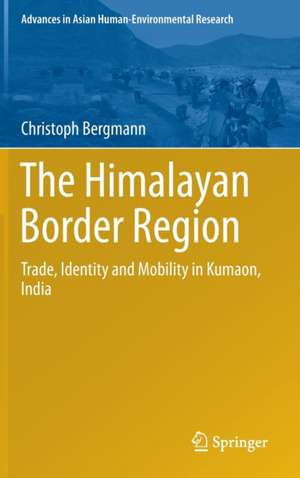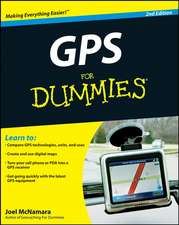The Himalayan Border Region: Trade, Identity and Mobility in Kumaon, India: Advances in Asian Human-Environmental Research
Autor Christoph Bergmannen Limba Engleză Hardback – 26 apr 2016
| Toate formatele și edițiile | Preț | Express |
|---|---|---|
| Paperback (1) | 636.12 lei 6-8 săpt. | |
| Springer International Publishing – 22 apr 2018 | 636.12 lei 6-8 săpt. | |
| Hardback (1) | 642.18 lei 6-8 săpt. | |
| Springer International Publishing – 26 apr 2016 | 642.18 lei 6-8 săpt. |
Din seria Advances in Asian Human-Environmental Research
- 18%
 Preț: 956.81 lei
Preț: 956.81 lei - 20%
 Preț: 560.01 lei
Preț: 560.01 lei - 18%
 Preț: 890.54 lei
Preț: 890.54 lei - 18%
 Preț: 788.72 lei
Preț: 788.72 lei - 15%
 Preț: 645.47 lei
Preț: 645.47 lei - 24%
 Preț: 725.19 lei
Preț: 725.19 lei - 18%
 Preț: 948.16 lei
Preț: 948.16 lei - 18%
 Preț: 787.78 lei
Preț: 787.78 lei - 15%
 Preț: 640.37 lei
Preț: 640.37 lei - 15%
 Preț: 646.43 lei
Preț: 646.43 lei - 15%
 Preț: 665.58 lei
Preț: 665.58 lei - 18%
 Preț: 948.16 lei
Preț: 948.16 lei - 15%
 Preț: 635.31 lei
Preț: 635.31 lei - 20%
 Preț: 578.30 lei
Preț: 578.30 lei - 15%
 Preț: 647.73 lei
Preț: 647.73 lei - 18%
 Preț: 1029.13 lei
Preț: 1029.13 lei - 15%
 Preț: 640.06 lei
Preț: 640.06 lei - 18%
 Preț: 950.52 lei
Preț: 950.52 lei - 18%
 Preț: 1575.88 lei
Preț: 1575.88 lei - 18%
 Preț: 896.08 lei
Preț: 896.08 lei - 15%
 Preț: 639.41 lei
Preț: 639.41 lei - 15%
 Preț: 645.28 lei
Preț: 645.28 lei - 15%
 Preț: 641.03 lei
Preț: 641.03 lei - 18%
 Preț: 954.62 lei
Preț: 954.62 lei - 15%
 Preț: 642.51 lei
Preț: 642.51 lei - 15%
 Preț: 644.95 lei
Preț: 644.95 lei - 18%
 Preț: 1023.74 lei
Preț: 1023.74 lei - 18%
 Preț: 954.31 lei
Preț: 954.31 lei - 15%
 Preț: 640.55 lei
Preț: 640.55 lei - 15%
 Preț: 644.18 lei
Preț: 644.18 lei - 15%
 Preț: 641.71 lei
Preț: 641.71 lei - 18%
 Preț: 938.21 lei
Preț: 938.21 lei - 15%
 Preț: 644.18 lei
Preț: 644.18 lei
Preț: 642.18 lei
Preț vechi: 755.51 lei
-15% Nou
Puncte Express: 963
Preț estimativ în valută:
122.90€ • 133.45$ • 103.23£
122.90€ • 133.45$ • 103.23£
Carte tipărită la comandă
Livrare economică 22 aprilie-06 mai
Preluare comenzi: 021 569.72.76
Specificații
ISBN-13: 9783319297057
ISBN-10: 3319297058
Pagini: 216
Ilustrații: XII, 195 p. 9 illus.
Dimensiuni: 155 x 235 x 13 mm
Greutate: 0.47 kg
Ediția:1st ed. 2016
Editura: Springer International Publishing
Colecția Springer
Seria Advances in Asian Human-Environmental Research
Locul publicării:Cham, Switzerland
ISBN-10: 3319297058
Pagini: 216
Ilustrații: XII, 195 p. 9 illus.
Dimensiuni: 155 x 235 x 13 mm
Greutate: 0.47 kg
Ediția:1st ed. 2016
Editura: Springer International Publishing
Colecția Springer
Seria Advances in Asian Human-Environmental Research
Locul publicării:Cham, Switzerland
Cuprins
Introduction.-Trans-Himalayan Trade in an Imperial Environment.-Ethnic Identities and Scalar Politics in a World of National States.-
Constellations of Mobility in a Market-Oriented Border Region.- Epilogue: Politics and Poetics of Central Himalayan Pastoralism.
Constellations of Mobility in a Market-Oriented Border Region.- Epilogue: Politics and Poetics of Central Himalayan Pastoralism.
Notă biografică
ChristophBergmann is a postdoctoral researcher in the Department ofGeography at the South Asia Institute, Heidelberg University (Germany). As aninterdisciplinary scholar with particular expertise in the domains of socialanthropology and geography, much of his work has sought to establish a locallyand historically contextualized understanding of stakeholder activities in HighAsia and, more recently, Sub-Saharan Africa. He adopts an actor-oriented approachto scrutinize processes of border-making and to unravel geographically andsocially uneven patterns of development, with a particular focus on theknowledge, aspirations and agendas of those considered as socio-economically orsocio-culturally marginal.
Textul de pe ultima copertă
Drawing from extensive archival work and long-term ethnographic research, this book focuses on the so-called Bhotiyas, former trans-Himalayan traders and a Scheduled Tribe of India who reside in several high valleys of the Kumaon Himalaya. The area is located in the border triangle between India, the Tibet Autonomous Region (TAR, People’s Republic of China), and Nepal, where contestations over political boundaries have created multiple challenges as well as opportunities for local mountain communities. Based on an analytical framework that is grounded in and contributes to recent advances in the field of border studies, the author explores how the Bhotiyas have used their agency to develop a flourishing trans-Himalayan trade under British colonial influence; to assert an identity and win legal recognition as a tribal community in the political setup of independent India; and to innovate their pastoral mobility in the context of ongoing state and market reforms. By examining the Bhotiyas’ trade, identity and mobility this book shows how and why the Himalayan border region has evolved as an agentive site of political action for a variety of different actors.
Caracteristici
Based on a localized and historically grounded case study, readers receive novel insights into the Himalayan border region Three empirical chapters provide readers with an innovative analysis of the relationships between trade, identity and mobility By advancing current debates on borderlands and transboundary environments, the book offers several key lessons for future research




